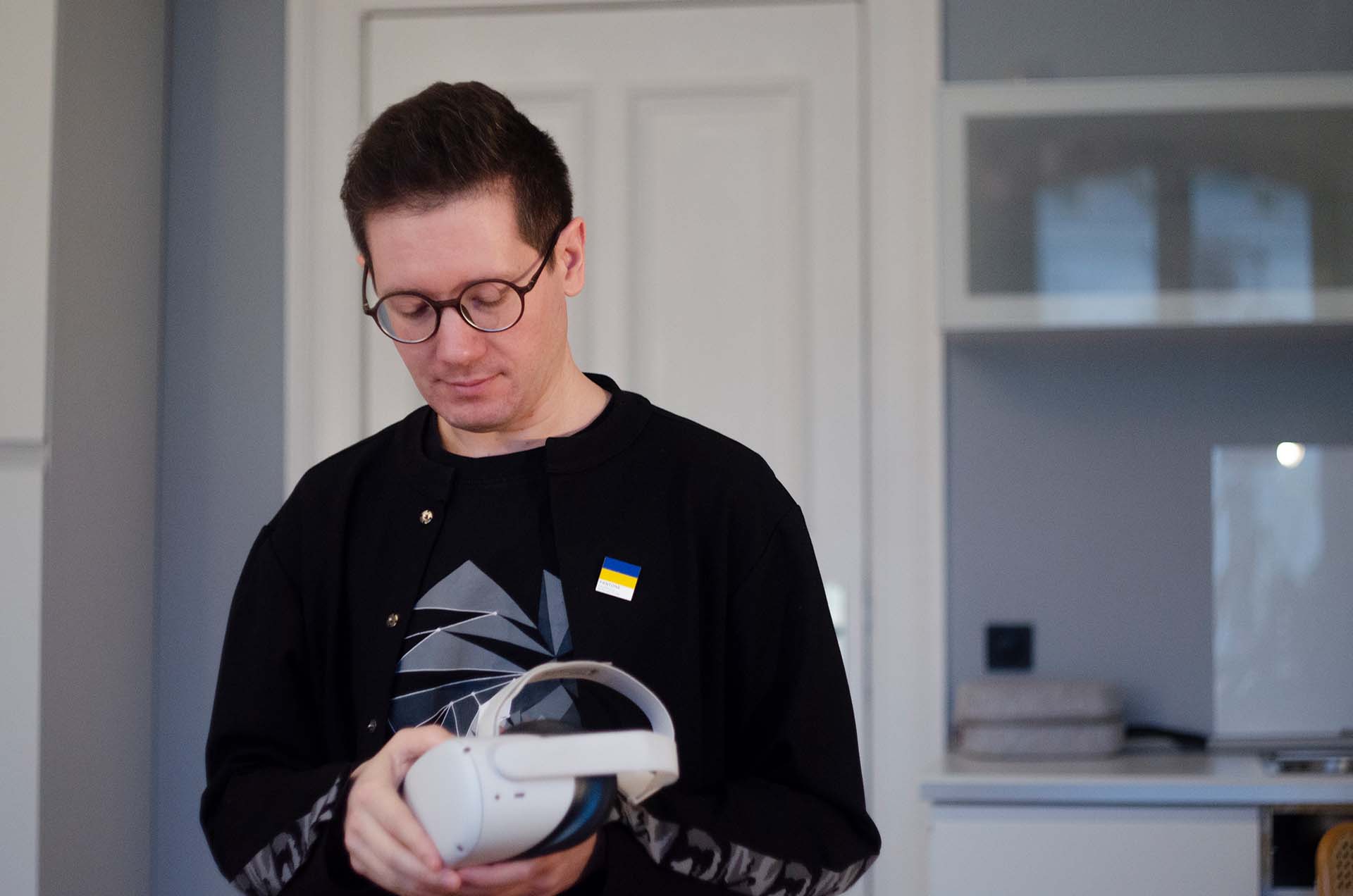People who
Mykyta Hudiakov is a media artist, and leader of the CryptoArt Ukraine NFT artists community. He was a member of the jury and a speaker of the educational part of Hatathon 3.0 NFT, co-organised by the House of Europe.
He is a curator of the social NFT project Collective Ukraine and festivals dedicated to VR art. He is also a creator of virtual galleries in the metauniverse and a media artist in the multidisciplinary performance P.A.N.TER. He mainly works with XR, AV and generative art.
We spoke with Mykyta about the adaptation of the Ukrainian NFT community to the war, the demand for digital artists from Ukraine, and the creation of new artistic NFT diasporas abroad.
He is a curator of the social NFT project Collective Ukraine and festivals dedicated to VR art. He is also a creator of virtual galleries in the metauniverse and a media artist in the multidisciplinary performance P.A.N.TER. He mainly works with XR, AV and generative art.
We spoke with Mykyta about the adaptation of the Ukrainian NFT community to the war, the demand for digital artists from Ukraine, and the creation of new artistic NFT diasporas abroad.

Since the beginning of the full-scale war, the Ukrainian cryptocurrency and NFT market has been difficult. As a result, there is less money in the field.
However, it did not stop digital artists. Despite all this, they continue creating new NFT projects, building relationships with collectors, organising exhibitions, performances, etc.
Mykyta Hudiakov is one of the media artists that continued creating during the war. He was born in Mykolaiv but lived and worked in Kharkiv for a long time. Before the war, he planned to hold a festival of his CryptoArt community in Kyiv and to develop the NFT community. But 24 February 2022 made changes in his life.
‘For three months after the beginning of the war, I could not listen to music. It was a severe indicator of my low emotional state. But, in many ways, thanks to the NFT community, where everybody supports each other and you have an opportunity to share your worries, I continued moving on and did not give up.
Before the war, we helped each other to develop professionally. Still, after 24 February 2022, the NFT community in general and CryptoArt Ukraine artists’ community became a place where you can find support in difficult situations.
At some moment, we even hired a psychotherapist who helped the artists to cope with complex psychological states in the war context for free.’
Since the beginning of the full-scale Russian aggression, the artistic community and crypto artists have become one of the voices of Ukraine in the international arena. Thanks to art, every day, more people learn the truth about the war in our country and crimes against civilians conducted by Russians. And they also learn what they can do to help Ukraine.
‘A vivid example of the change of the art’s focus is the Oil-Blood-Liberty exhibition of Ukrainian crypto artists in Hannover, organised together with CryptoArt, Mykyta states. In the exhibition programme, there was a panel discussion on how to minimise the import of energy resources from Russia to Germany.’
During the first two weeks of March, the works of Ukrainian crypto artists were actively sold on the global crypto market. In the first place, it was an act of support. This interest in Ukrainian media art remained during the year.
However, it did not stop digital artists. Despite all this, they continue creating new NFT projects, building relationships with collectors, organising exhibitions, performances, etc.
Mykyta Hudiakov is one of the media artists that continued creating during the war. He was born in Mykolaiv but lived and worked in Kharkiv for a long time. Before the war, he planned to hold a festival of his CryptoArt community in Kyiv and to develop the NFT community. But 24 February 2022 made changes in his life.
‘For three months after the beginning of the war, I could not listen to music. It was a severe indicator of my low emotional state. But, in many ways, thanks to the NFT community, where everybody supports each other and you have an opportunity to share your worries, I continued moving on and did not give up.
Before the war, we helped each other to develop professionally. Still, after 24 February 2022, the NFT community in general and CryptoArt Ukraine artists’ community became a place where you can find support in difficult situations.
At some moment, we even hired a psychotherapist who helped the artists to cope with complex psychological states in the war context for free.’
Since the beginning of the full-scale Russian aggression, the artistic community and crypto artists have become one of the voices of Ukraine in the international arena. Thanks to art, every day, more people learn the truth about the war in our country and crimes against civilians conducted by Russians. And they also learn what they can do to help Ukraine.
‘A vivid example of the change of the art’s focus is the Oil-Blood-Liberty exhibition of Ukrainian crypto artists in Hannover, organised together with CryptoArt, Mykyta states. In the exhibition programme, there was a panel discussion on how to minimise the import of energy resources from Russia to Germany.’
During the first two weeks of March, the works of Ukrainian crypto artists were actively sold on the global crypto market. In the first place, it was an act of support. This interest in Ukrainian media art remained during the year.
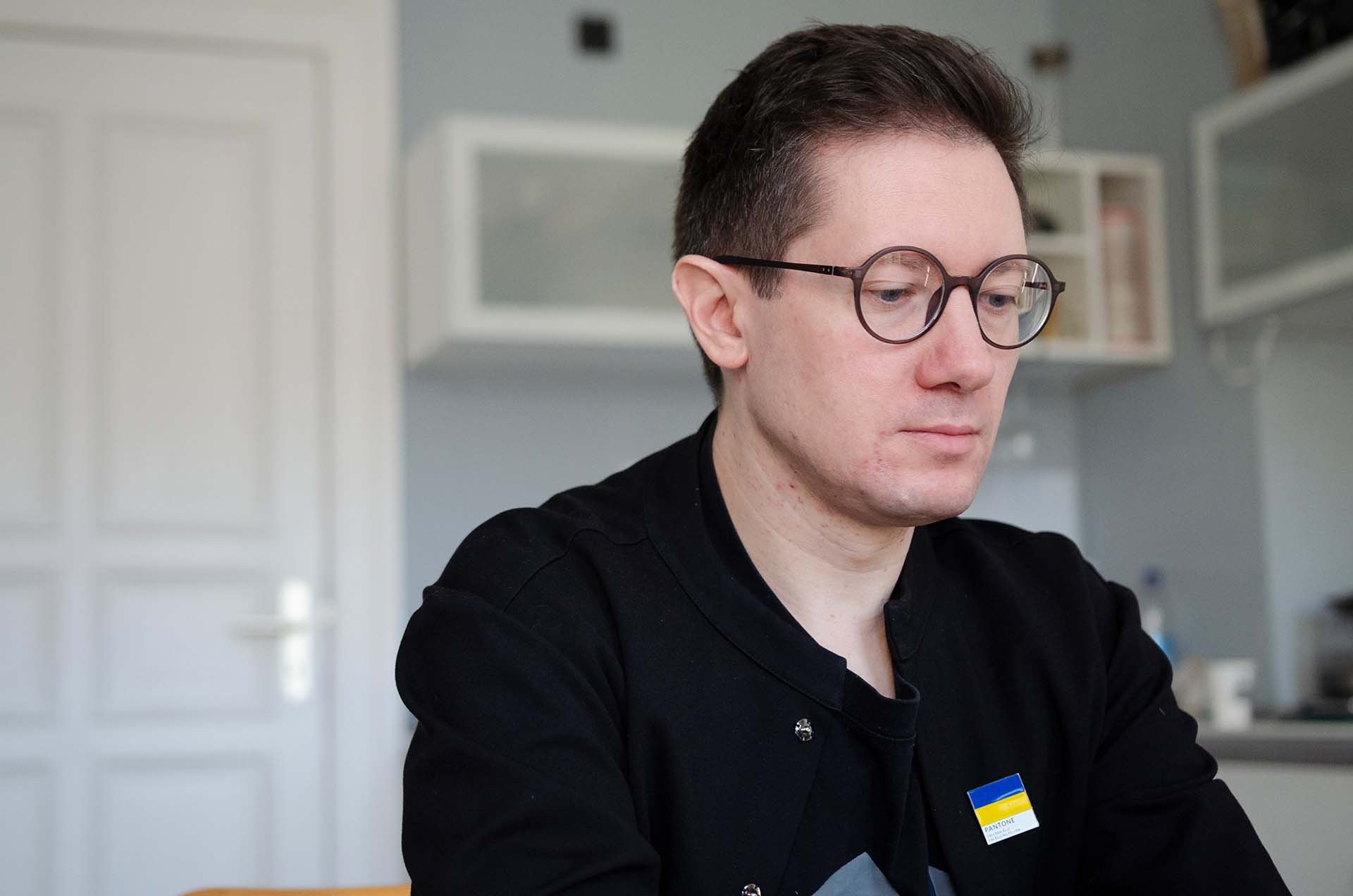
Digital art: war edition
Hatathon 3.0 became a ‘witness’ and a proof of resilience and viability of Ukrainian NFT in 2022. It is an anti-crisis creative and technical marathon in support of culture. The event was organised by the House of Europe programme jointly with Goethe-Institut in Ukraine and Digitizing.Space. NFT became the topic of the event.
Mykyta was invited to become a jury member of the hackathon. Holding such an event in the middle of the war was not a surprise for him, as such events encourage the Ukrainian NFT community to keep up with the times, culture and technology.
‘The world is not standing still, waiting for us to win. The same is with the NFT world, Mykyta assures. If we, Ukrainians, do not develop in different fields, we will be left in the dust, losing precious time.
That is why it is imperative to hold such events. It helps create products that will be relevant in the world and will be globally competitive.’
Such events as hackathons are also crucial because they help to gather more money to help Ukraine. In addition, they help our country find new ways of fundraising. And, of course, it is an opportunity for creative people to find a new development space. That is why Hatathon 3.0 NFT Edition and hackathons, in general, encourage the development of the Ukrainian technological world.
‘This year’s topic of the Hatathon is NFT, a global community, so it was comparatively easy to find speakers from other countries, Mykyta states. I invited some speakers from CryptoArtUkraine. I also helped inform the Ukrainian NFT community about the hackathon and that they can take part in it.’
Thirteen participants out of 216 teams reached the final of this year’s hackathon. Some people were especially memorable for Mykyta. Although, he is a little bit disappointed that some art projects he liked did not win. However, those teams gained great experience and many valuable acquaintances to develop their projects further.
‘I really liked the presentation of the Vydra Richkova team with Shobtobi project that suggested making 100 audio-visual NFTs with Ukrainian curse words; Mykyta shares his impression. Their idea was remarkable, with a clear format, but at the same time funny, and the jury liked it. They stood out from other participants by the way they presented themselves.’
Hatathon 3.0 became a ‘witness’ and a proof of resilience and viability of Ukrainian NFT in 2022. It is an anti-crisis creative and technical marathon in support of culture. The event was organised by the House of Europe programme jointly with Goethe-Institut in Ukraine and Digitizing.Space. NFT became the topic of the event.
Mykyta was invited to become a jury member of the hackathon. Holding such an event in the middle of the war was not a surprise for him, as such events encourage the Ukrainian NFT community to keep up with the times, culture and technology.
‘The world is not standing still, waiting for us to win. The same is with the NFT world, Mykyta assures. If we, Ukrainians, do not develop in different fields, we will be left in the dust, losing precious time.
That is why it is imperative to hold such events. It helps create products that will be relevant in the world and will be globally competitive.’
Such events as hackathons are also crucial because they help to gather more money to help Ukraine. In addition, they help our country find new ways of fundraising. And, of course, it is an opportunity for creative people to find a new development space. That is why Hatathon 3.0 NFT Edition and hackathons, in general, encourage the development of the Ukrainian technological world.
‘This year’s topic of the Hatathon is NFT, a global community, so it was comparatively easy to find speakers from other countries, Mykyta states. I invited some speakers from CryptoArtUkraine. I also helped inform the Ukrainian NFT community about the hackathon and that they can take part in it.’
Thirteen participants out of 216 teams reached the final of this year’s hackathon. Some people were especially memorable for Mykyta. Although, he is a little bit disappointed that some art projects he liked did not win. However, those teams gained great experience and many valuable acquaintances to develop their projects further.
‘I really liked the presentation of the Vydra Richkova team with Shobtobi project that suggested making 100 audio-visual NFTs with Ukrainian curse words; Mykyta shares his impression. Their idea was remarkable, with a clear format, but at the same time funny, and the jury liked it. They stood out from other participants by the way they presented themselves.’
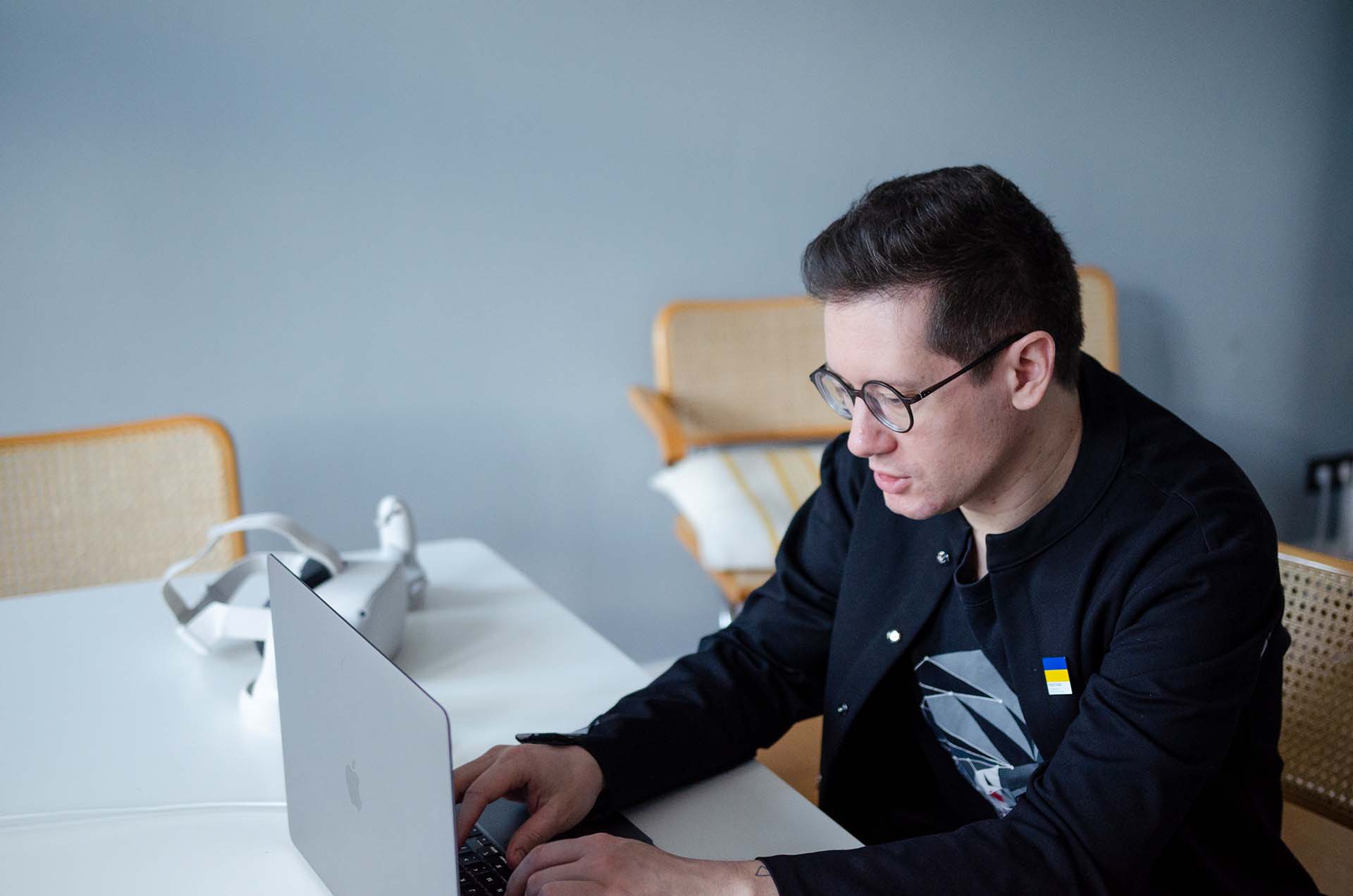
Ilona Demchenko, a programme manager of House of Europe, also believes that Vydra Richkova’s project was very timely as after 24 February 2022, the Ukrainians use curse words more often.
‘In my opinion, the team worked on the topic with good taste without crossing the line, Ilona highlights. Their project stood out thanks to the unusual subject. It worked in raising additional awareness of the Ukrainian language and received a very emotional reaction from the audience and the jury.
In the Hatathon, we always encouraged unusual ideas and approaches and did not seek censorship, so here we were also glad to support something unique.’
Despite the competitive spirit, this year there was much more solidarity among the participants of the hackathon than the year before. During the event, Mykyta got inspired by reviewing the works of participating teams. In addition, he strengthened communication between the speakers and structured his own knowledge.
‘In my opinion, the team worked on the topic with good taste without crossing the line, Ilona highlights. Their project stood out thanks to the unusual subject. It worked in raising additional awareness of the Ukrainian language and received a very emotional reaction from the audience and the jury.
In the Hatathon, we always encouraged unusual ideas and approaches and did not seek censorship, so here we were also glad to support something unique.’
Despite the competitive spirit, this year there was much more solidarity among the participants of the hackathon than the year before. During the event, Mykyta got inspired by reviewing the works of participating teams. In addition, he strengthened communication between the speakers and structured his own knowledge.
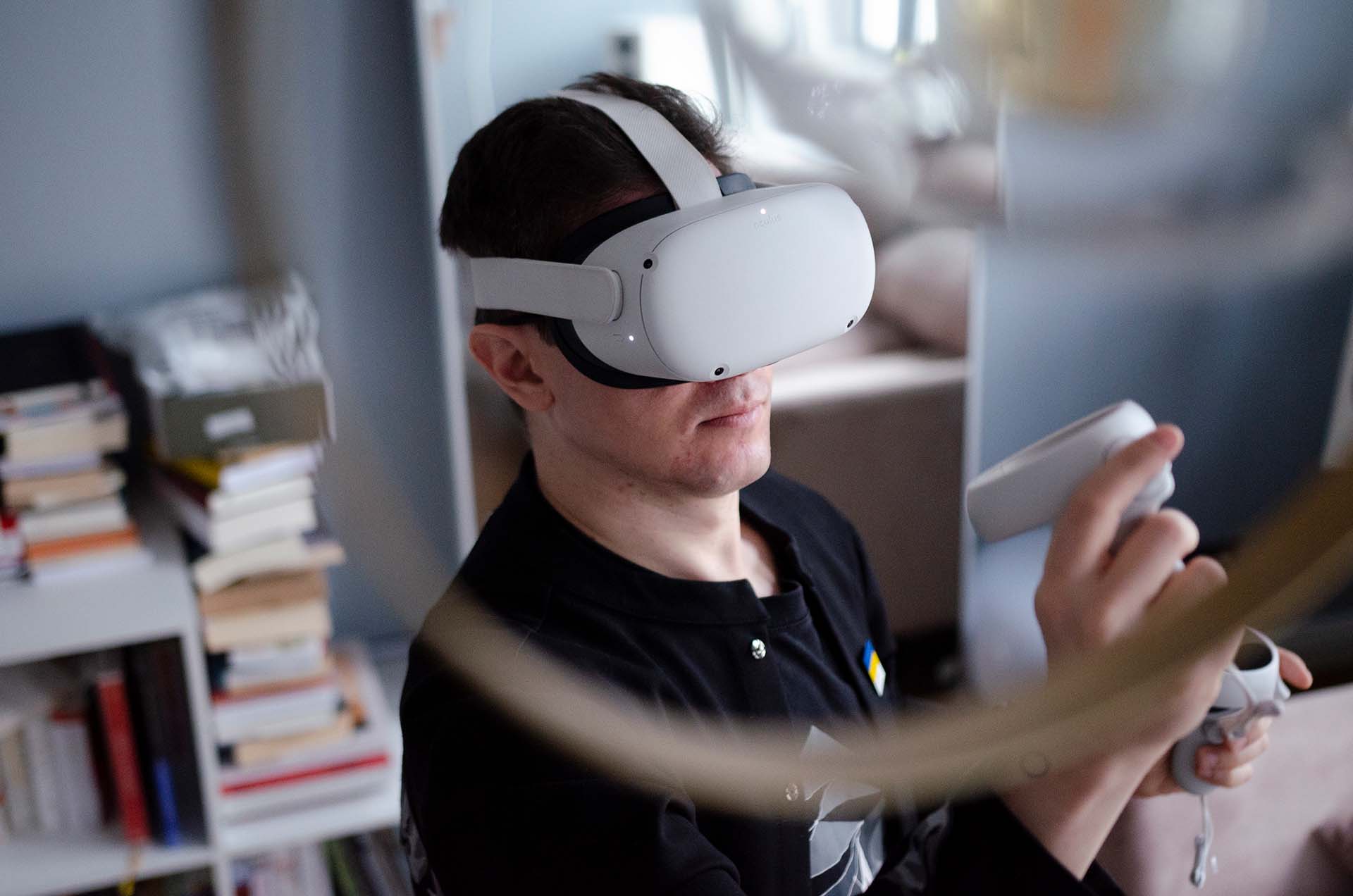
Participants, mentors, and organisers of the hackathon took part in one “social soup”, making new acquaintances. And this communication is one of the most important results of the event
‘I, for example, met Jonas Lund, one of the speakers, media-artist, and later on, we met in his workshop in Berlin. We talked a lot about what NFT is now, what projects he and I work on’ , Mykyta says.
NFT-diaspora and plans
Unity, readiness and a common goal helped the Ukrainian NFT to stay afloat in the stormy 2022.
Mykyta says that during the war CryptoArt Ukraine community became a place not only for the professional development of artists but also for comprehensive help: providing mini grants and actively publishing different opportunities about art residences and exhibitions those willing could take part in.
In November 2022 Mykyta moved to Berlin. He gets inspired by the local NFT community and works on an audio-visual performance where music will influence visual effects. He plans to transform the fragments of this performance into an appropriate format so it can be bought as an NFT product.
Even abroad, Mykyta continues supporting the Ukrainian NFT community, and buys the works of other artists. For example, he has recently purchased the piece by Vitalii Shumanskii, a media artist who took part in the Hydro Gen project as a lead programmer. This project combines poetry, statistics on water pollution, political issues, and digital art.
‘As a CryptoArt Ukraine leader, I continue actively presenting Ukrainian NFT abroad, Mykyta shares. Talking about the last events – CryptoArt Ukraine’s participation in international exhibitions: Art Basel in Miami, Web Summit in Lisbon, Ukrainian NFT art exhibition Oil-Blood-Liberty in Germany, that I already talked about.’
It recently became known that the projects of several Ukrainian media artists will be presented at the NFT.NYC conference in New York, which will take place on 12-14 April. The works will be broadcast on giant screens in Times Square, one of the most recognisable locations in the city.
Mykyta shares his own list of top Ukrainian media artists that admire and inspire him, famous not only in Ukraine but in the global crypto world. Among them are Yura Myron, who has been engaged in NFT since 2019 and Iryna Bashuk, who experiments at the intersection of modern dance and digital art.
Now, Mykyta tries to build cultural bridges between the Ukrainian and global NFT communities and learns about the institutions ready to support Ukraine. He plans to organise an exhibition of Ukrainian media artists in Berlin and is currently negotiating with several local galleries. Because NFT has no borders, it is a kind of universal language for artists from all over the world, a key to interesting events, people and opportunities.
For now, Ukrainian artists are treated with respect in the global crypto field. And they have the ‘green light’ to share their stories and tell the international community about the war in Ukraine through crypto art.
‘Even though there are many other information occasions in the world, we must continue to convey important information about events in Ukraine with the help of cultural projects’, Mykyta assures.
NFT-diaspora and plans
Unity, readiness and a common goal helped the Ukrainian NFT to stay afloat in the stormy 2022.
Mykyta says that during the war CryptoArt Ukraine community became a place not only for the professional development of artists but also for comprehensive help: providing mini grants and actively publishing different opportunities about art residences and exhibitions those willing could take part in.
In November 2022 Mykyta moved to Berlin. He gets inspired by the local NFT community and works on an audio-visual performance where music will influence visual effects. He plans to transform the fragments of this performance into an appropriate format so it can be bought as an NFT product.
Even abroad, Mykyta continues supporting the Ukrainian NFT community, and buys the works of other artists. For example, he has recently purchased the piece by Vitalii Shumanskii, a media artist who took part in the Hydro Gen project as a lead programmer. This project combines poetry, statistics on water pollution, political issues, and digital art.
‘As a CryptoArt Ukraine leader, I continue actively presenting Ukrainian NFT abroad, Mykyta shares. Talking about the last events – CryptoArt Ukraine’s participation in international exhibitions: Art Basel in Miami, Web Summit in Lisbon, Ukrainian NFT art exhibition Oil-Blood-Liberty in Germany, that I already talked about.’
It recently became known that the projects of several Ukrainian media artists will be presented at the NFT.NYC conference in New York, which will take place on 12-14 April. The works will be broadcast on giant screens in Times Square, one of the most recognisable locations in the city.
Mykyta shares his own list of top Ukrainian media artists that admire and inspire him, famous not only in Ukraine but in the global crypto world. Among them are Yura Myron, who has been engaged in NFT since 2019 and Iryna Bashuk, who experiments at the intersection of modern dance and digital art.
Now, Mykyta tries to build cultural bridges between the Ukrainian and global NFT communities and learns about the institutions ready to support Ukraine. He plans to organise an exhibition of Ukrainian media artists in Berlin and is currently negotiating with several local galleries. Because NFT has no borders, it is a kind of universal language for artists from all over the world, a key to interesting events, people and opportunities.
For now, Ukrainian artists are treated with respect in the global crypto field. And they have the ‘green light’ to share their stories and tell the international community about the war in Ukraine through crypto art.
‘Even though there are many other information occasions in the world, we must continue to convey important information about events in Ukraine with the help of cultural projects’, Mykyta assures.
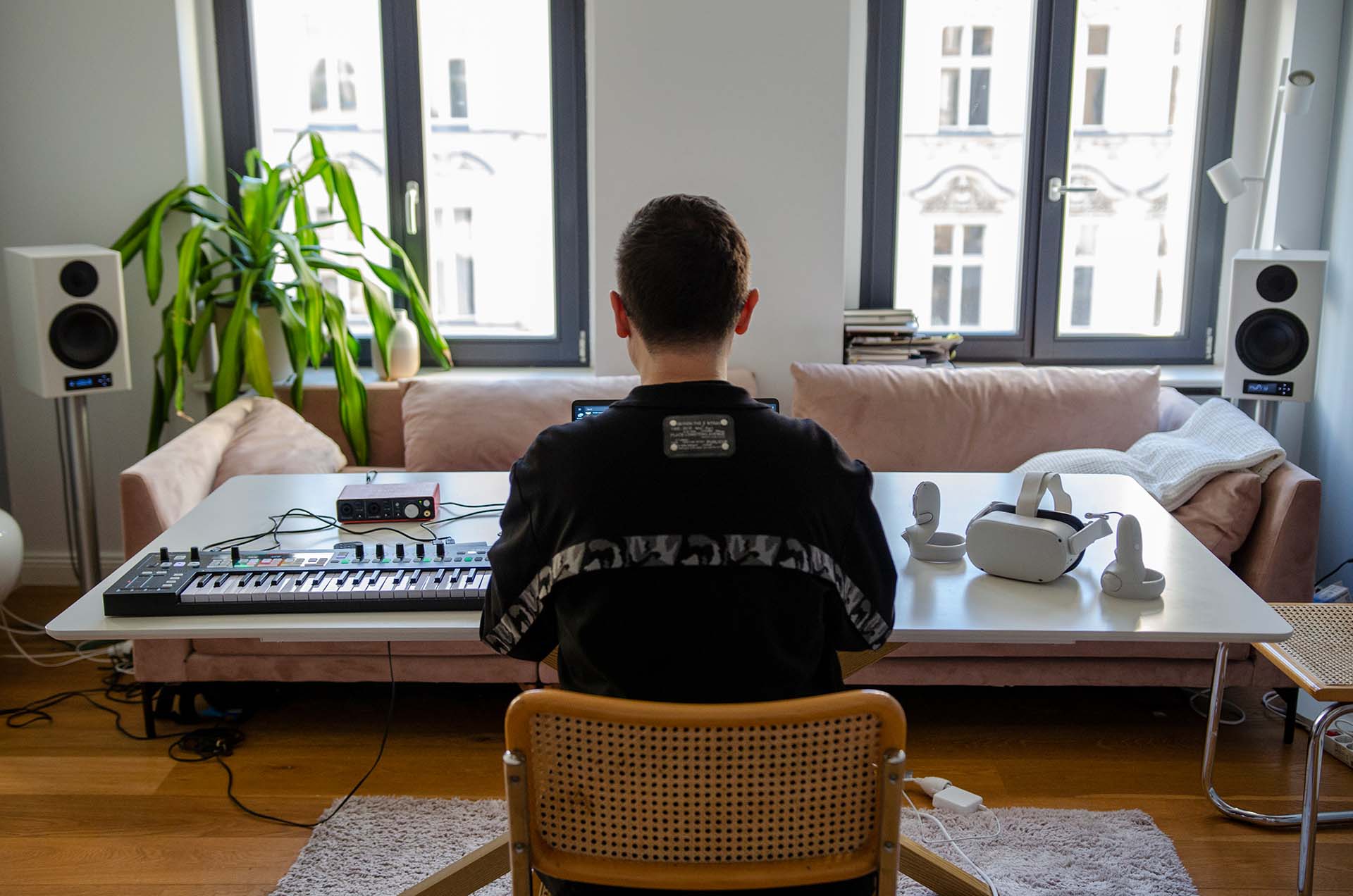
It will be difficult for the global NFT community to focus on the events happening in our country for a long time. That is why we need to keep being unique and creative. I am sure that Ukraine is and will be an important player in the international cultural field and the global NFT artists’ community. And I am sure we will win this war with joint efforts
Valeriia Merenkova, photos — from a personal archive
Back to main page
